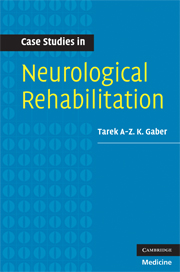Book contents
- Frontmatter
- Contents
- Preface
- Part I Clinical rehabilitation
- Part II Case studies
- 3 Medical issues in brain injury rehabilitation
- 4 Progressive neurological disorders
- 5 Medical complications of immobility
- 6 Orthotics in neurological rehabilitation
- 7 Ethical and medicolegal controversies
- 8 Chronic pain
- 9 Medically unexplained disorders
- 10 Spasticity management
- 11 Ventilatory support in rehabilitation
- 12 Sphincteric dysfunction
- 13 Communication disabilities
- 14 Sensory disability
- 15 Prescriptions for independence
- Part III Exercises in neurological rehabilitation
- Index
9 - Medically unexplained disorders
from Part II - Case studies
Published online by Cambridge University Press: 13 August 2009
- Frontmatter
- Contents
- Preface
- Part I Clinical rehabilitation
- Part II Case studies
- 3 Medical issues in brain injury rehabilitation
- 4 Progressive neurological disorders
- 5 Medical complications of immobility
- 6 Orthotics in neurological rehabilitation
- 7 Ethical and medicolegal controversies
- 8 Chronic pain
- 9 Medically unexplained disorders
- 10 Spasticity management
- 11 Ventilatory support in rehabilitation
- 12 Sphincteric dysfunction
- 13 Communication disabilities
- 14 Sensory disability
- 15 Prescriptions for independence
- Part III Exercises in neurological rehabilitation
- Index
Summary
The medical model of diagnosis and management depends on taking a clinical history, examining the patient and then requesting appropriate investigations. Ideally, this will lead to a diagnosis and formulation of a management plan. Considering this model, it is easy to appreciate the frustration of the treating clinicians when dealing with patients with medically unexplained disorders, as the history is usually non-specific, clinical examination and investigations show no abnormality and the pathology and diagnosis are duly unclear.
Medically unexplained disorders will fit more comfortably with the rehabilitation model of dealing with illness. A focus on disability and handicap is the cornerstone of rehabilitation practice. The nature or severity of the disability and handicap are not necessarily a direct consequence of the pathology or impairment. An epileptic may have pathology but no impairment or disability. However, the impact of the epilepsy on the patient's social or vocational activities may be substantial. A patient with chronic back pain may have no pathology, but the impairment and disability will be significant.
This different way of thinking puts the rehabilitation specialists in a better position when dealing with patients suffering from a medically unexplained disorder. Rehabilitation services are also used routinely to explore social, psychological and vocational issues. These factors are usually the main targets for intervention in such patients.
- Type
- Chapter
- Information
- Case Studies in Neurological Rehabilitation , pp. 101 - 109Publisher: Cambridge University PressPrint publication year: 2008



